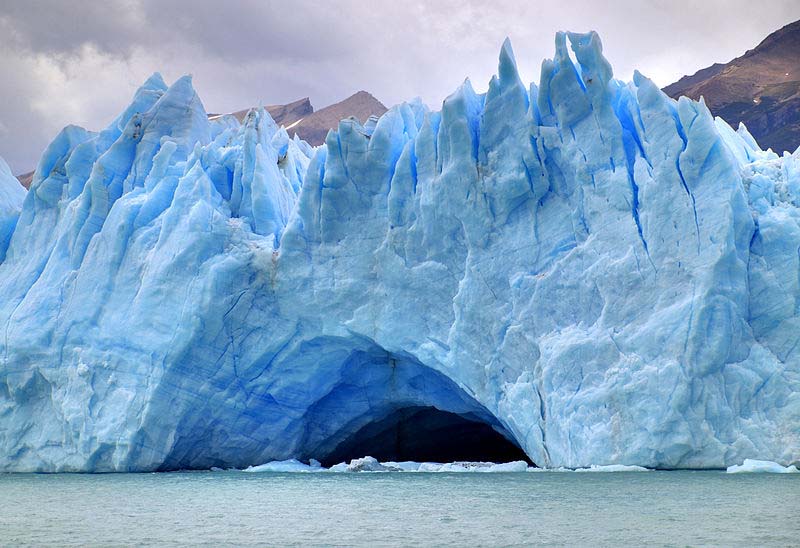
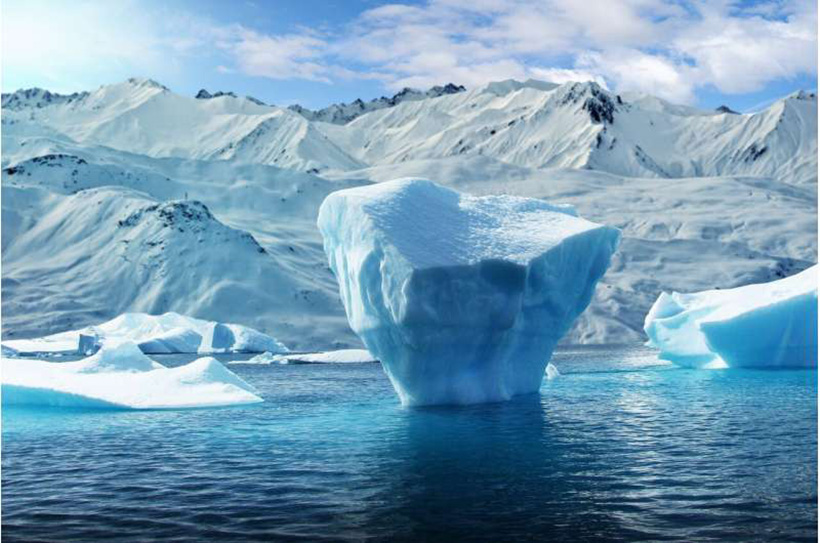
Planet Earth is rapidly changing - icebergs in the Arctic and Antarctic regions
along other areas - breaking away every day resulting in a rise in sea levels.


Planet Earth is rapidly changing - icebergs in the Arctic and Antarctic regions
along other areas - breaking away every day resulting in a rise in sea levels.
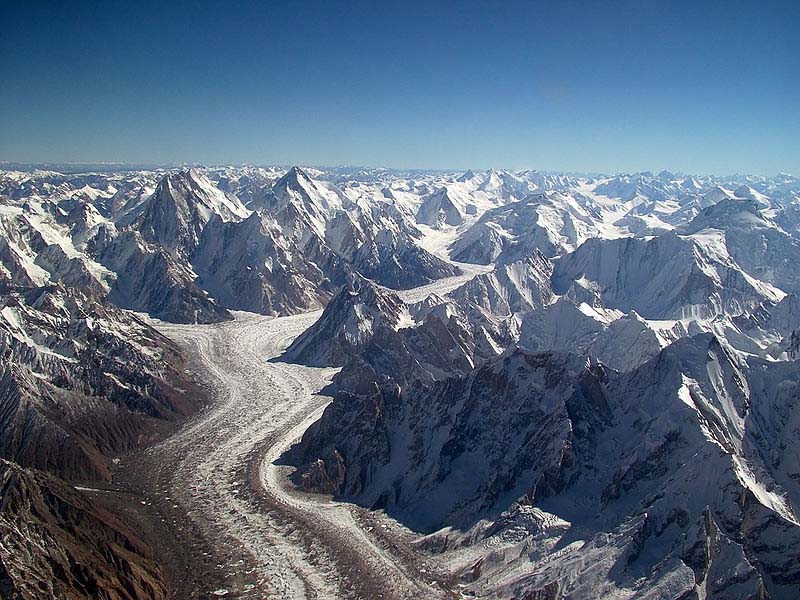
Across the world glaciers are melting at accelerating rates highlighted in Antarctica, Greenland, and the Arctic .
A glacier is a large mass of ice moving slowly over some land surface or down a valley, formed over long periods from the accumulation of snow in areas where the amount of snow that falls exceeds the amount that melts.
Glacier ice is the largest reservoir of fresh water on Earth, and second only to oceans as the largest reservoir of total water. Glaciers cover vast areas of the polar regions and are found in mountain ranges of every continent except Australia, although there are glaciers on New Zealand. In the tropics glaciers are restricted to the highest mountains. The processes and landforms caused by glaciers and related to them are referred to as glacial. The process of glacier growth and establishment is called glaciation. Glaciers are sensitive monitors of climate conditions and are crucial to both world water resources and sea level variation.
Glaciers slowly deform and flow due to stresses induced by their weight, creating crevasses, seracs, and other distinguishing features. They also abrade rock and debris from their substrate to create landforms such as cirques and moraines. Glaciers form only on land and are distinct from the much thinner sea ice and lake ice that form on the surface of bodies of water.
On Earth, 99% of glacial ice is contained within vast ice sheets in the polar regions, but glaciers may be found in mountain ranges on every continent, and on a few high-latitude oceanic islands. Between 35°N and 35°S, glaciers occur only in the Himalayas, Andes, a few high mountains in East Africa, Mexico, New Guinea and on Zard Kuh in Iran.
Glacial ice is the largest reservoir of freshwater on Earth. Many glaciers from temperate, alpine and seasonal polar climates store water as ice during the colder seasons and release it later in the form of meltwater as warmer summer temperatures cause the glacier to melt, creating a water source that is especially important for plants, animals and human uses when other sources may be scant. Within high altitude and Antarctic environments, the seasonal temperature difference is often not sufficient to release meltwater.
Because glacial mass is affected by long-term climate changes, e.g., precipitation, mean temperature, and cloud cover, glacial mass changes are considered among the most sensitive indicators of climate change and are a major source of variations in sea level. Read more ...
An iceberg is a large piece of freshwater ice that has broken off from a snow-formed glacier or ice shelf and is floating in open water. It may subsequently become frozen into pack ice or come to rest on the seabed in shallower water, causing ice scour, also known as ice gouging. Read more ...
World Glacier Day
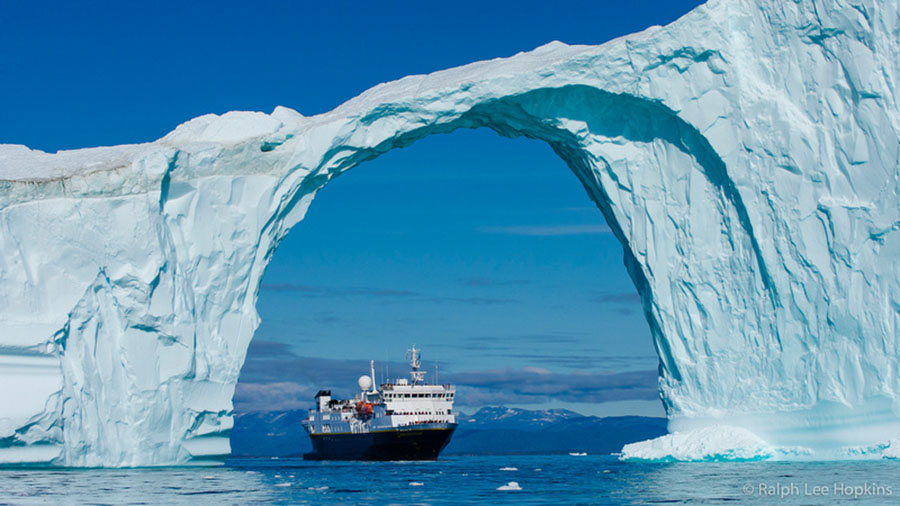

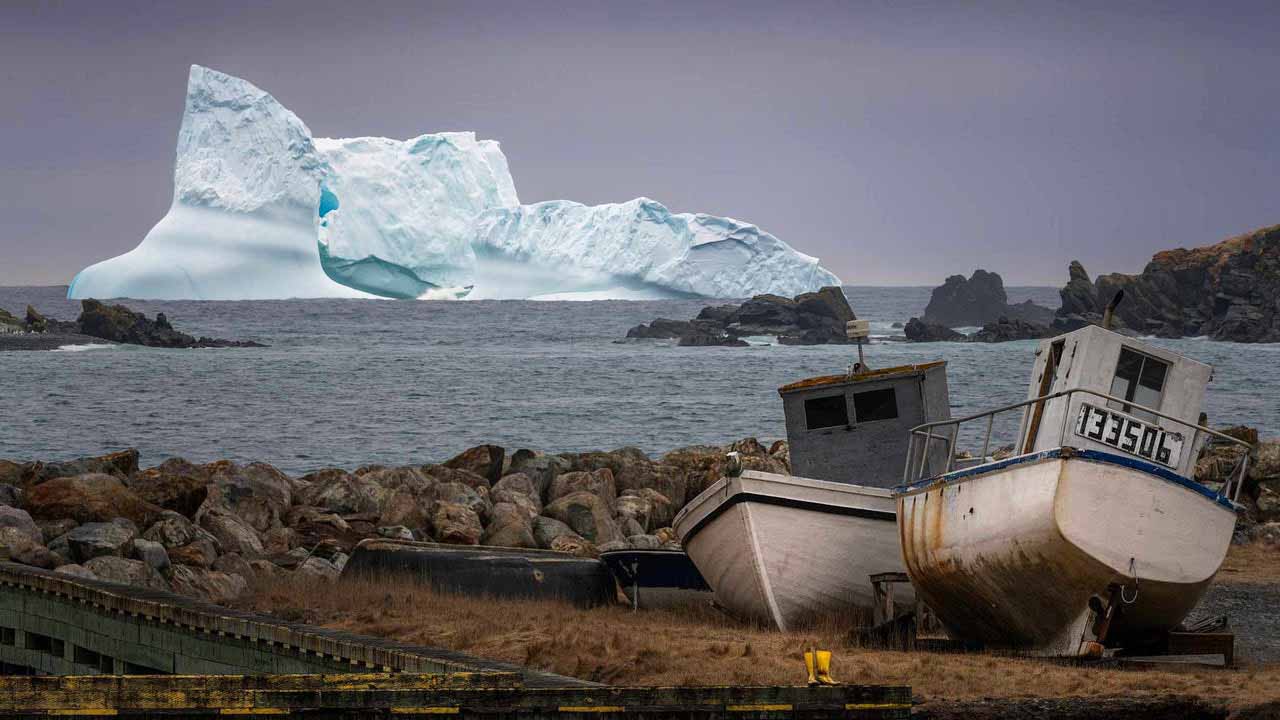
April is the heart of the season for viewing icebergs near the coasts of Newfoundland and Labrador, Canada. There is an iceberg alley where these chunks of ice calve off from western Greenland's ice shelf, then are steered by ocean currents as far south as some North Atlantic shipping lanes (remember the Titanic?). Only an estimated 1% of all the icebergs produced off Greenland make it that far south. But some are truly giants, dwarfing coastal locations (as you can see in the photo above). Weather.com - April 26, 2023
Visualize huge glaciers splitting apart forming a waterway due to climate change.
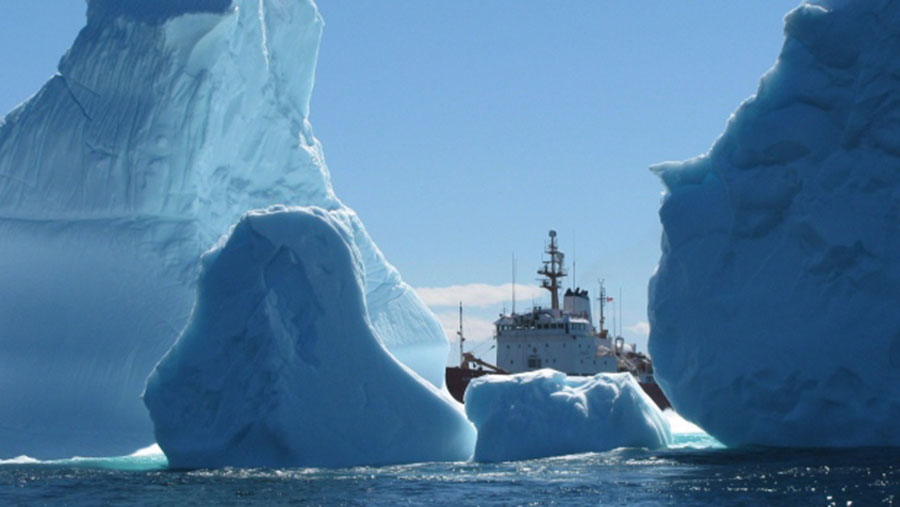
Sounds beautiful ... and yet there is always drama especially when it comes to money.

How will the Northwest Passage influence global trade? Aljazeera - April 28, 2016
Global warming may be the reason behind rising sea levels, extreme weather conditions and the deaths of Arctic animals. But while the environment suffers, the shipping industry has seen a massive new opportunity. The melting ice is opening up a new trade route through the Arctic Ocean, which China and other countries are planning to benefit from. The newly navigable Northwest Passage connects the Pacific Ocean and the Atlantic, and shipping industry leaders in China say the route shortens the journey by 30 percent. But what claim does China and others have on this region?
China's Northwest Passage Ambitions Could Challenge Canada's Sovereignty: Expert Huffington Post - April 28, 2016
A guidebook produced by China's Maritime Safety Administration (MSA) shows that the People's Republic wants to use Canada's northern waters as a shortcut to the Atlantic. Ships currently have to reach it through the Panama Canal - a route that takes about 40 per cent more time.
The Northwest Passage is a sea route connecting the northern Atlantic and Pacific Oceans through the Arctic Ocean, along the northern coast of North America via waterways through the Canadian Arctic Archipelago. The various islands of the archipelago are separated from one another and from the Canadian mainland by a series of Arctic waterways collectively known as the Northwest Passages or Northwestern Passages. The Parliament of Canada renamed these waterways the "Canadian Northwest Passage" in a motion that was passed unanimously in December 2009.
Sought by explorers for centuries as a possible trade route, it was discovered in 1850 by Robert McClure and first navigated by Norwegian explorer Ronald Amundsen with a small expedition in 1903-1906. Until 2009, the Arctic pack ice prevented regular marine shipping throughout most of the year. Change in the pack ice (Arctic shrinkage) has rendered the waterways more navigable. The contested sovereignty claims over the waters may complicate future shipping through the region: the Canadian government considers the Northwestern Passages part of Canadian Internal Waters, but the United States and various European countries maintain they are an international strait and transit passage, allowing free and unencumbered passage. If, as has been claimed, parts of the eastern end of the Passage are barely 15 metres (49 ft) deep, the route's viability as a Euro-Asian shipping route is reduced. Read more
Underwater glacier-guarding walls could have unintended consequences PhysOrg - September 15, 2025

Warm water flowing into fjords and beneath ice shelves will continue to be a prime cause of glacial melting as global temperatures rise. This melting will, in turn, contribute to sea level rise and increasing inundation of coastal areas. As emission reductions fall short of international goals, scientists and some members of the public are discussing possibilities for using geoengineering to mitigate coastal flooding and other detrimental effects of climate warming.
When does melting ice capsize? New research unearths several mechanisms PhysOrg - September 15, 2025

Rising temperatures of the world's oceans threaten to accelerate the melting and splintering of glaciers—thereby potentially increasing the number of icebergs and, with it, the need to better understand more about their movement and impact. Through a series of experiments, a team of scientists has pinpointed some of the factors that cause icebergs to capsize, offering insights into how climate change may affect Earth's waters.
Arctic: Using ice cores and underwater drones, scientists found something gliding within the frozen water. They say it changes what we know about how life survives in extreme environments. BBC Magazine - September 11, 2025

If you found yourself in the unlikely position of diving beneath the Arctic ice pack, you may notice what looks like a layer of dirt lining the frozen undersurface. Despite appearing lifeless, this green film is in fact very much alive – and not only that, but it’s also moving, a new study has found. The coloration is caused by vast communities of microscopic algae known as diatoms.
'Space ice' is less like water than previously thought PhysOrg - July 8, 2025

"Space ice" contains tiny crystals and is not a completely disordered material like liquid water, as previously assumed. Ice in space is different from the crystalline (highly ordered) form of ice on Earth.
Ice in Space Could Do Something We Thought Was Impossible - Create Crystals Science Alert - July 7, 2025
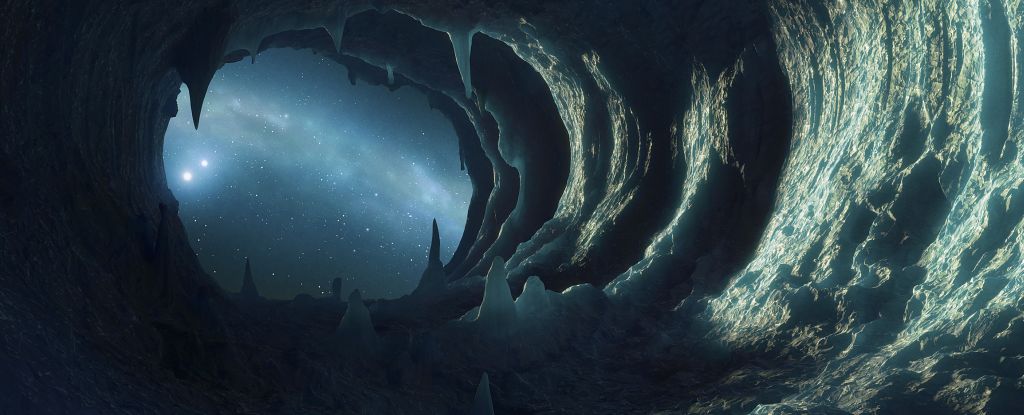
A new research effort using computer simulations and experiments to explore the most common form water takes in the Universe has found that it is not as structureless as scientists had thought. Rather, repeating patterns – otherwise known as crystals – just a few nanometers across are likely embedded in an otherwise frozen jumble of molecules.
Rare Black Iceberg in the Labrador Sea 0ff Canada Goes Viral - So What Is Going on Here? Science Alert - June 13, 2025

A fisherman at sea off the coast of Canada recorded something that few humans have ever seen. Floating serenely amid the pale ice chunks in the Labrador Sea was one iceberg that appeared as black as soot. Hallur Antoniussen, aboard the fishing trawler Saputi in mid-May, was gobsmacked - but fortunately not too gobsmacked to capture the strange sight and post it to social media.
World's glacier mass shrank again in 2024, says UN PhysOrg - March 21, 2025


All 19 of the world's glacier regions experienced a net loss of mass in 2024 for the third consecutive year, the United Nations said Friday, warning that saving the planet's glaciers was now a matter of survival. Five of the last six years have seen the most rapid glacier retreat on record, the UN's World Meteorological Organization said on the inaugural World Day for Glaciers. They are rapidly shrinking due to climate change. Based on a compilation of worldwide observations, the WGMS estimates that glaciers - separate from the continental ice sheets in Greenland and Antarctic - have lost more than 9,000 billion tonnes since records began in 1975
First major chunk breaks off world's biggest iceberg in a possible first sign the behemoth from Antarctica could be crumbling PhysOrg - February 1, 2025

This monster block of freshwater was being whisked along by the world's most powerful ocean "jet stream" - the Antarctic Circumpolar Current.
The world's biggest iceberg is on the move after decades of being grounded on the seafloor in Antarctica Science Alert - November 24, 2023
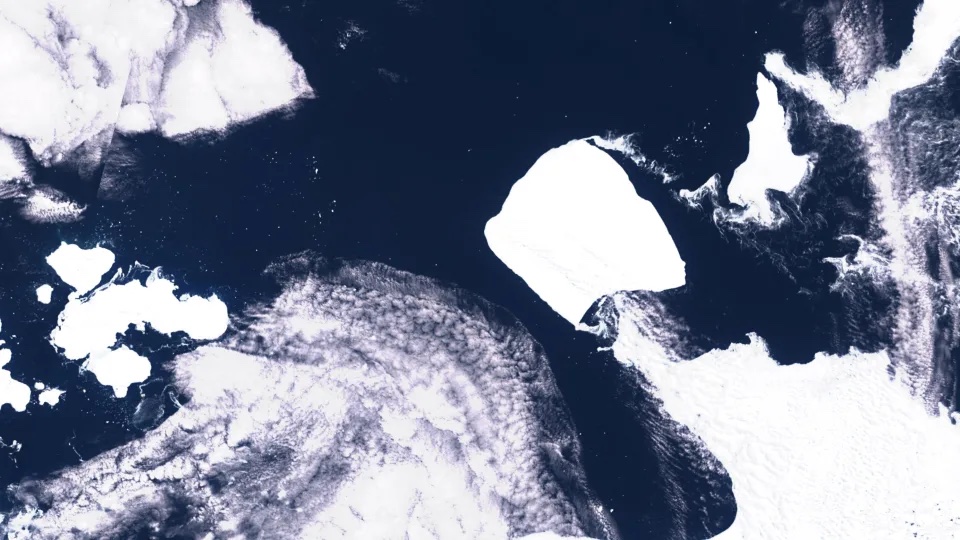
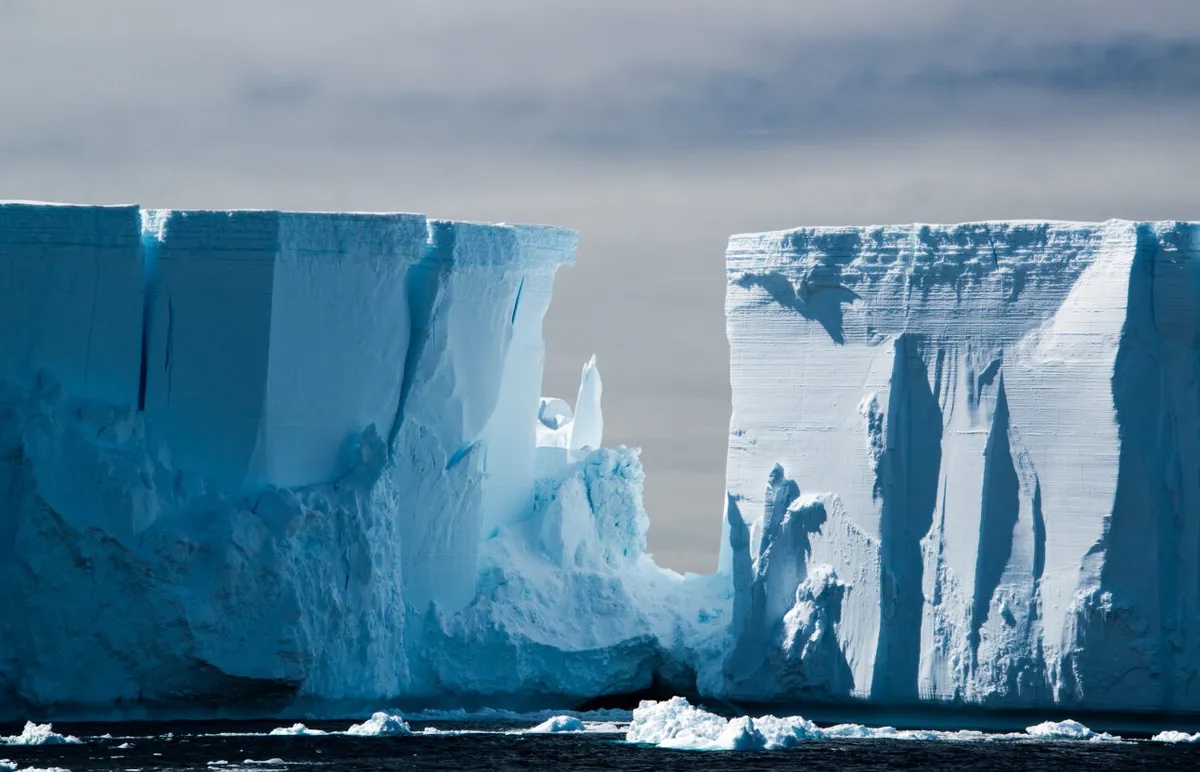
The huge mass of ice broke away from the Filchner-Ronne ice shelf in 1986, calved and grounded on the Antarctic’s Weddell Sea floor almost immediately. The iceberg, named A23a, is about 400 meters (1,312 feet) thick, and almost 4,000 square kilometers (1,544 square miles) in area. Greater London, by way of comparison, is 1,572 square kilometers (607 square miles).
World's oldest glacier dates to 2.9 billion years ago, research finds Live Science - July 22, 2023

Evidence of the world's oldest glacier is hiding near South Africa's gold fields, a new study reports. The glacial sediments date back 2.9 billion years. Video
Scientists think they've uncovered evidence of the oldest glaciers ever found, in ancient rocks speckled with oxygen isotopes lying beneath the world's largest gold deposits in South Africa Science Alert - March 22, 2025
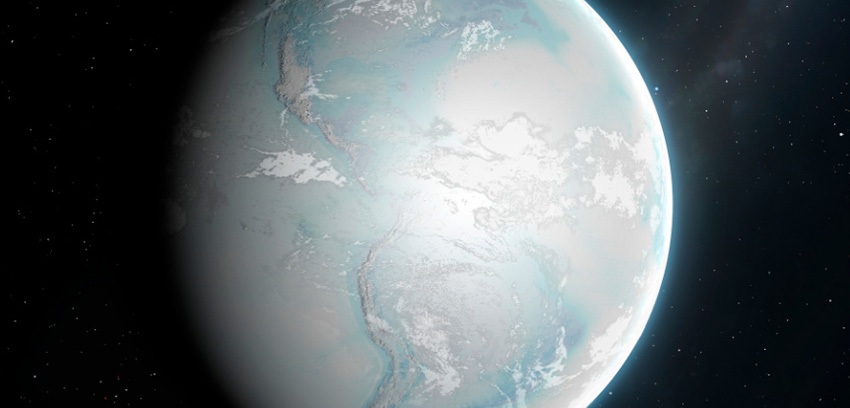
The discovery could add new lines to an early chapter in Earth's turbulent history, and may explain how those goldfields formed. A research team analyzed rock beds situated near Durban on the east coast of South Africa that contain glacial deposits estimated to be 2.9 billion years old, making them the oldest known on Earth. Rocks that old have had a long time to experience a variety of geological changes. Luckily the Pongola Supergroup, as the layers of rock are known, has hardly been disturbed since it was laid down with the flooding of an inland sea all those years ago. This is one of the few areas which remain fairly intact and unchanged from the early Earth.
Giant phallus-shaped iceberg floating in Conception Bay surprises residents of Dildo, Canada Live Science - May 2, 2023
Photographer Ken Pretty from the Newfoundland town of Dildo has captured images of a penis-shaped iceberg off the Canadian coast - 30-foot (9.1 meter) tall. The suggestive 'berg consists of a column with a domed head protruding up from two oval rafts of ice. Pretty captured a shot of the ice formation by drone near the town of Harbour Grace, which sits along - the puns keep adding up - Conception Bay. Perhaps unsurprisingly, the "dickie berg," as locals are calling it, has attracted international attention, with Pretty sharing news stories from as far away as Thailand and Taiwan on his Facebook page.
Millions Are at Risk of Flooding Due to Climate Change - Melting Glaciers -> Glacier Lake Flooding Science Alert - February 7, 2023
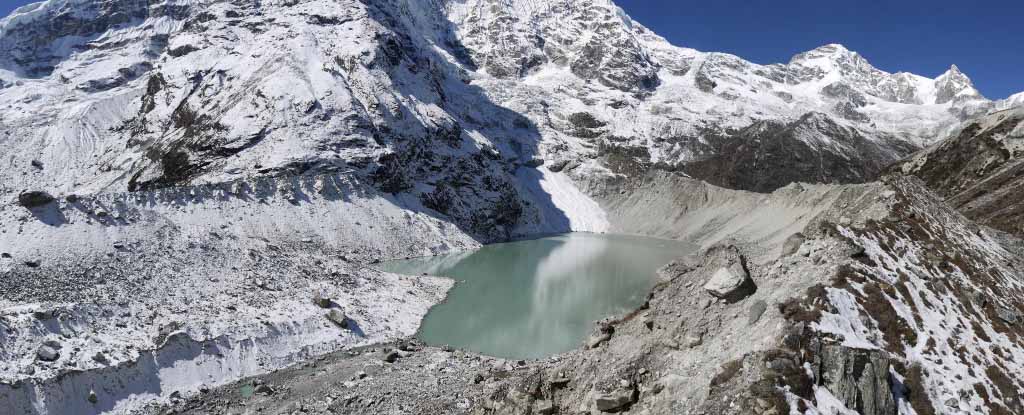
Glaciers are melting, putting the lives of millions around the world at risk of flash flooding, according to a new study. Most of those people reside in just four countries - India, Pakistan, Peru, and China - where glacial lakes are numerous and populations are vulnerable to climate disasters.
Rapidly Melting Glaciers Are Releasing a Staggering Payload of Unknown Bacteria Science Alert - November 24, 2022
Fast-melting glaciers are releasing staggering amounts of bacteria into rivers and streams, which could transform icy ecosystems, scientists warn. In a study of glacial runoff from 10 sites across the Northern Hemisphere, researchers have estimated that continued global warming over the next 80 years could release hundreds of thousands of tonnes of bacteria into environments downstream of receding glaciers.
Scientists Revived Ancient 'Zombie Viruses' Frozen For Eons in Siberia Science Alert - November 25, 2022
The Thwaites Glacier 'Doomsday Glacier' in Antarctica Is Holding on 'By Its Fingernails', Scientists Warn Science Alert - September 15, 2022
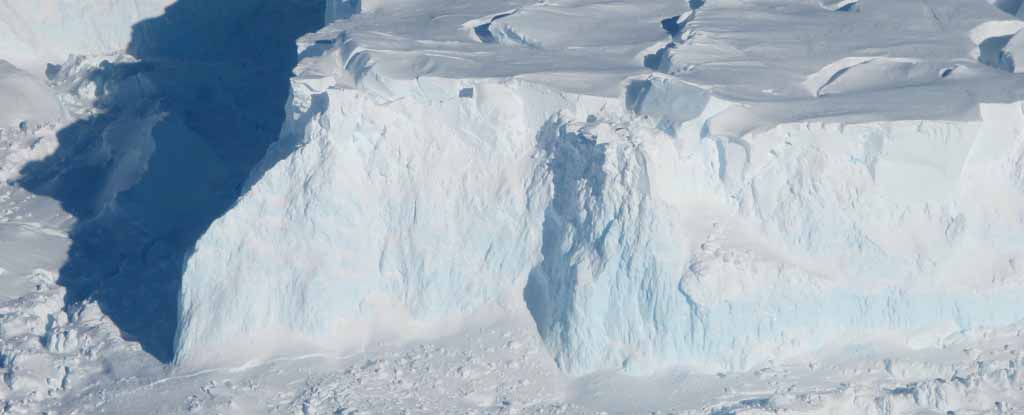
The melting of the Thwaites Glacier - which is around the size of Florida - could raise sea levels by up to two feet. It's that, and the fact that it acts as a buffer between warming seas and the much larger West Antarctic ice sheet, that gives it its ominous nickname. However, the new study, led by the University of South Florida (USF), found that the Thwaites glacier has melted far faster in past centuries than has been observed in recent years – meaning that a similar brisk pace of retreat could be triggered in the future. The researchers learned this by using underwater drones to map the sea floor under the glacier for the first time.
Arctic 'ghost island' that vanished may have actually been a iceberg grounded at the sea bottom Live Science - September 15, 2022
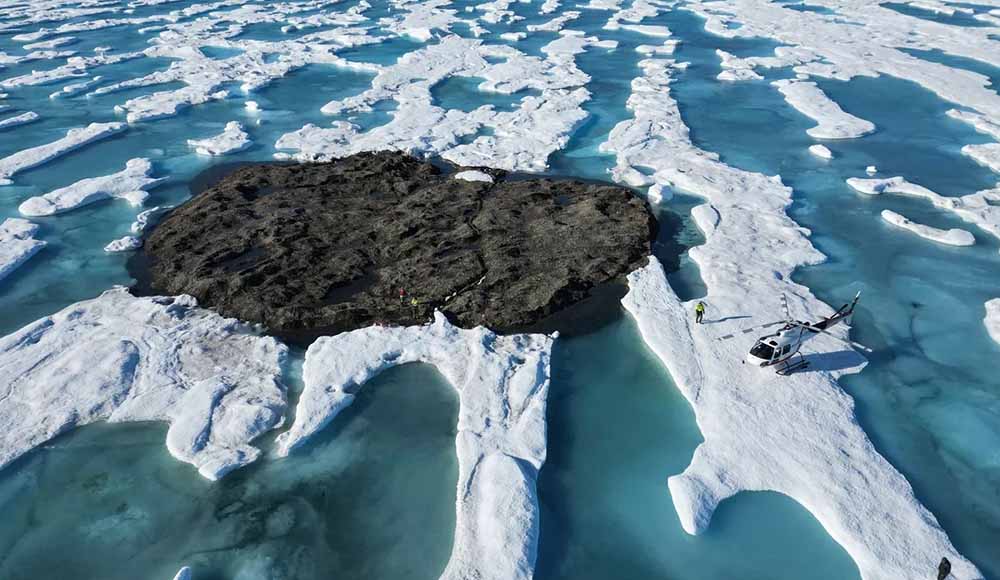
In 2021, an expedition off the icy northern Greenland coast spotted what appeared to be a previously uncharted island. It was small and gravelly, and it was declared a contender for the title of the most northerly known land mass in the world. The discoverers named it Qeqertaq Avannarleq - Greenlandic for the northernmost island. But there was a mystery afoot in the region. Just north of Cape Morris Jesup, several other small islands had been discovered over the decades, and then disappeared. hen a team of Swiss and Danish surveyors traveled north to investigate this "ghost islands" phenomenon, they discovered something else entirely. They announced their findings in September 2022: These elusive islands are actually large icebergs grounded at the sea bottom. They likely came from a nearby glacier, where other newly calved icebergs, covered with gravel from landslides, were ready to float off. This was not the first such disappearing act in the high Arctic, or the first need to erase land from the map. Nearly a century ago, an innovative airborne expedition redrew the maps of large swaths of the Barents Sea.
This goes to #4 on my list of the Origins of Covid
Never-before-seen microbes locked in glacier ice could spark a wave of new pandemics if released Live Science - July 1, 2022
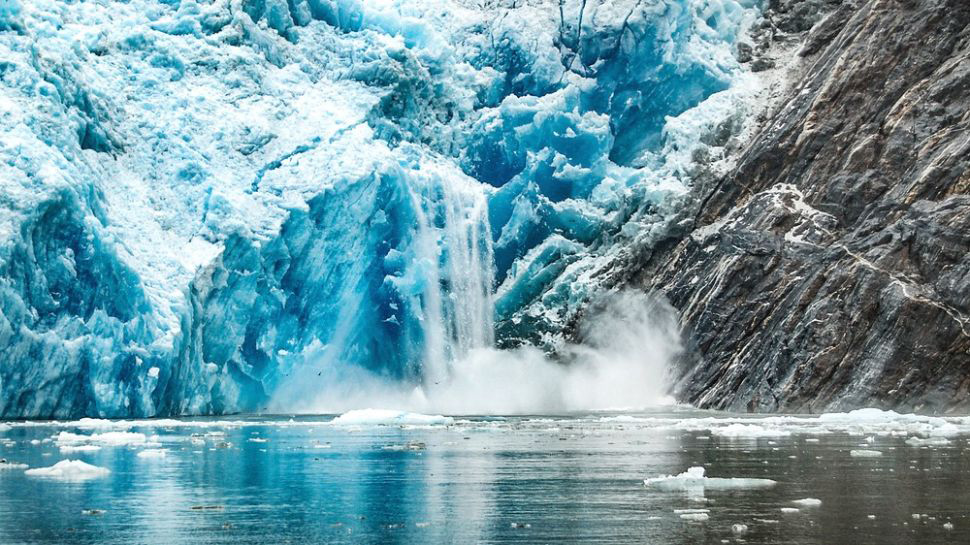
Stunned scientists have uncovered more than 900 never-before-seen species of microbes living inside glaciers on the Tibetan Plateau. Analysis of the microbes' genomes revealed that some have the potential to spawn new pandemics, if rapid melting caused by climate change releases them from their icy prison.
Patagonian ice fields are among some of the fastest-melting glaciers on the planet Science Alert - March 1, 2022
As these glaciers disappear, the earth that once lay beneath them is rebounding upwards at rates much faster than expected.
Mt. Everest's highest glacier lost 2,000 years worth of ice since the 1990s Live Science - February 7, 2022

Even the glaciers on Mount Everest are not safe from climate change, new research suggests. In a record-setting study, a team of scientists scaled the world's highest peak to monitor the mountain's highest-altitude glacier - the South Col Glacier, standing nearly 26,000 feet (8,000 meters) above sea level - for signs of climate-related ice loss. After installing the two highest weather stations on Earth and collecting the world's highest ice core from the glacier, the team found that South Col is losing ice roughly 80 times faster than it took for the ice to accumulate on the glacier's surface, they reported Feb. 3 in the journal npj Climate and Atmospheric Science.
So Much Ice Has Melted, That the Earth's Crust Is Shifting in Weird, New Ways - September 28, 2021
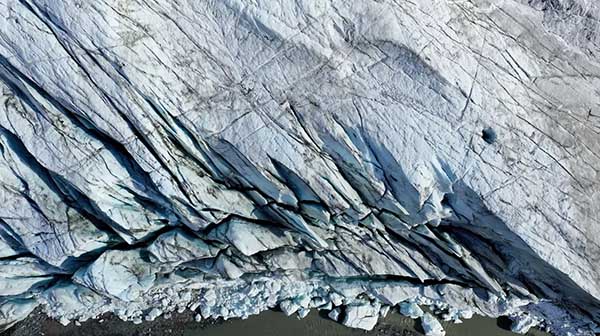
Both the Greenland and Antarctic ice sheets - the world's two largest bodies of ice - are melting at an alarming rate, causing major problems for local ecosystems and coastal communities alike. Now, in yet more evidence that the climate crisis is changing everything in bizarre and profound ways, new research suggests that the meltdown is warping the Earth's crust.
Ice Melt at The Poles Is Now Causing Hidden Changes to Earth's Crust on a Huge Scale Science Alert - September 24, 2021
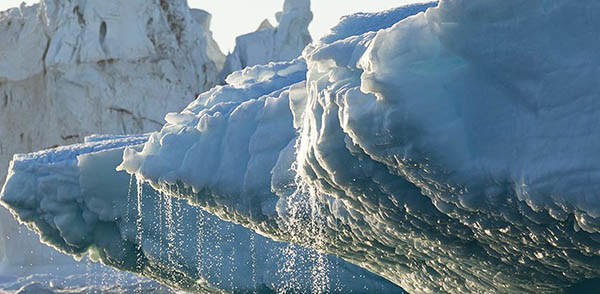
As the polar ice sheets melt, the process is not just raising sea levels - it's also warping the underlying surface of Earth, a new study reveals, and some of the effects can be seen across thousands of miles.
An enormous Antarctic iceberg A68 whose journeys were probably the most well-documented in history has now melted away to nothing in the Atlantic ocean Science Alert - April 21, 2021

A68 cracked off the Larsen C ice sheet on the Antarctic Peninsula in 2017 as one of the biggest icebergs ever. At the time, it measured 2,240 square miles (5,800 square kilometers), about the size of the state of Delaware. In the time since, the berg has been buffeted about the South Atlantic, curving up toward South Georgia Island. There, warm temperatures and waves broke it into large chunks. Those chunks have since fragmented into pieces too small to track. The U.S. National Ice Center tracks icebergs that are at least 10 nautical miles (18.5 kilometers) in length or that have an area of at least 20 square nautical miles (68.5 sq km). The largest piece of Larsen C no longer qualifies as of April 16, according to the Center's database: It measured only 3 nautical miles by 2 nautical miles (5.5 km by 3.7 km).
Ice Loss Will Trigger Increased Warming in a Vicious Feedback Loop Science Alert - October 28, 2020

The loss of billions of tonnes of ice from Earth's frozen spaces is likely to increase global temperatures by an additional 0.4 degrees Celsius, according to research Tuesday highlighting the danger of a "vicious circle" of warming.
Arctic sea ice goes through 'historic' loss in 2020 Live Science - October 30, 2020
Arctic sea ice has been in decline for a while now, but 2020 is turning out to be by far one of the worst years ever. Every year, like clockwork, the northern ice cap, or sea ice, shrinks in the spring and summer reaching its minimum extent in September and then it grows in the fall and winter to reach its maximum extent in March. But as carbon dioxide and other greenhouse gas emissions have warmed the planet, the area covered by this summer sea ice has gotten smaller and smaller. And the ice has failed to reach its usual maximum extent in the winter. This is a change that's come on fast, with recent years producing much worse sea ice even than the period from 1981 to 2010. But even compared with the worst years of the last decade, this summer has been devastating.
Greenland ice melt is changing the shape of its coastline Live Science - October 30, 2020
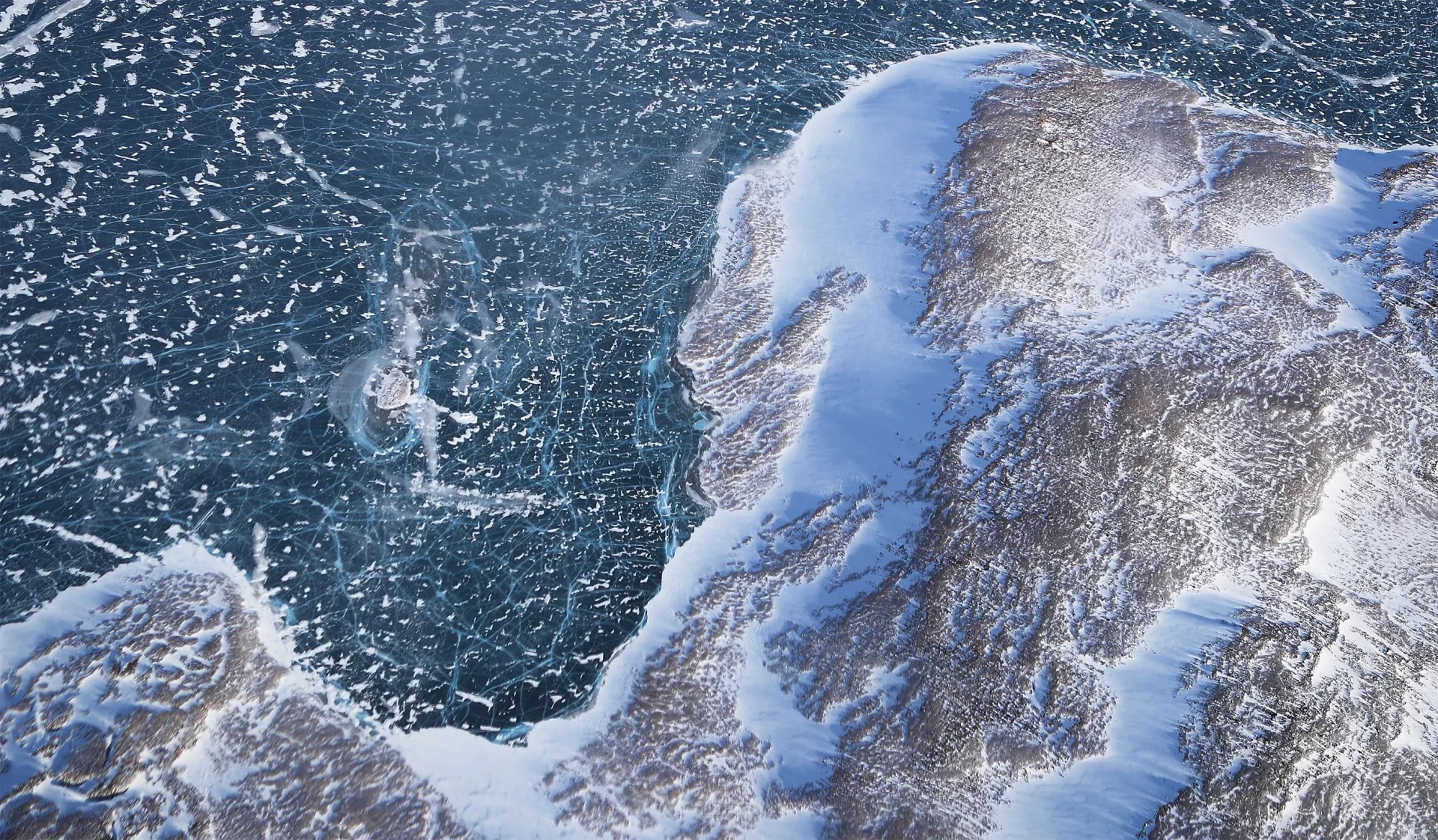
Rapid melt is reshaping coastal Greenland, potentially altering the human and animal ecosystems along the country's coast. New research finds that the ice retreat in Greenland has changed the way glaciers flow and where they dump into the sea. These changes could impact ice loss from Greenland in the future, the researchers wrote.
Half of Antarctic ice shelves could collapse in a flash, thanks to warming Live Science - August 27, 2020

Antarctic ice shelves can disappear astonishingly fast - sometimes in minutes or hours - as meltwater surges through cracks in their surface. And as the atmosphere warms, this phenomenon may become more commonplace; at least half of the ice shelves on the continent are vulnerable to this process.
Earth Lost a 'Staggering' 28 Trillion Tonnes of Ice in Just 23 Years Science Alert - August 24, 2020
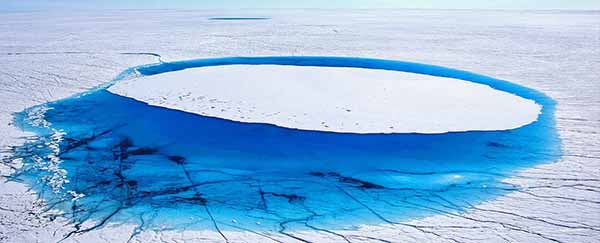
Scientists from Leeds and Edinburgh universities and University College London analyzed satellite surveys of glaciers, mountains, and ice sheets between 1994 and 2017 to identify the impact of global warming.
Possible connection between ice and Earth's magnetic history PhysOrg - June 29, 2020

To measure the magnetism of the 'ice cores' created in a lab, where a sensitive magnetometer and been installed allowed scientists to measure the very slightest of magnetic moments. The team found a small, but definitely detectible magnetic moment that matched the magnetic fields applied to their ice samples.
Spooky 'blood snow' invades Antarctic island Live Science - February 26, 2020
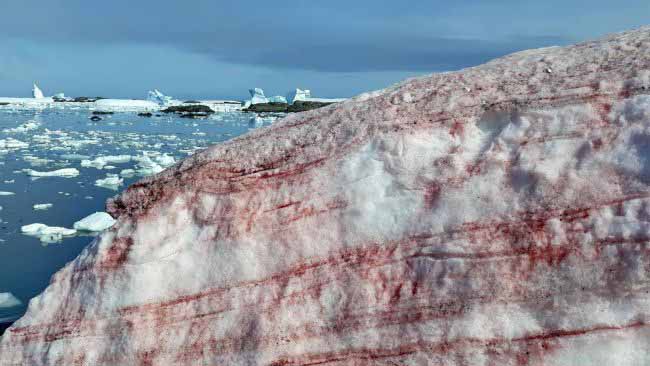
It's summer in Antarctica, which means record-high temperatures, jarring glacial melt and - in a very metal symbol of our changing climate - a bit of blood-red snow spattered across the Antarctic Peninsula. Over the past several weeks, the ice around Ukraine's Vernadsky Research Base (located on Galindez Island, off the coast of Antarctica's northernmost peninsula) has been coated in what researchers are calling "raspberry snow." A Facebook post by the Ministry of Education and Science of Ukraine shows the scene in full detail: streaks of red and pink slashing across the edges of glaciers and puddling on the frosty plains.
One of Antarctica's fastest-shrinking glaciers just lost an iceberg twice the size of Washington, D.C. Live Science - February 11, 2020

Pine Island Glacier, one of the fastest-shrinking glaciers in Antarctica, has just lost another huge chunk of ice to the sea, continuing a troubling trend that has become a near-annual occurrence in the last decade. Scientists at Copernicus, the European Union's Earth observation program, have been closely monitoring the glacier since large cracks appeared near its edge in October 2019. Yesterday, those cracks finally cut a chunk of the glacier away (a process known as calving), releasing a giant jigsaw puzzle of fresh icebergs into the nearby Amundsen Sea. In total, the icebergs measure about twice the size of Washington, D.C., in area (more than 130 square miles, or 350 square kilometers). On its own, the recent calving event is not entirely surprising or particularly threatening to global sea levels; calving is a normal part of life for ice formations with sections that float on the water, according to NASA's Earth Observatory. Because ice at the edge of the glacier was already floating, this ice will not directly contribute to sea level rise when it inevitably melts.
World's biggest iceberg makes a run for it
The world's biggest iceberg is about to enter the open ocean. BBC - February 6, 2020
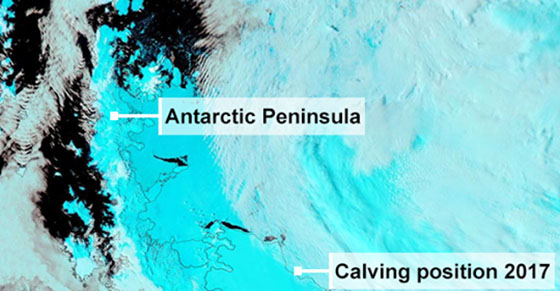
A68, a colossus that broke free from the Antarctic in 2017, has pushed so far north it is now at the limit of the continent's perennial sea-ice. When it calved, the berg had an area close to 6,000 sq km (2,300 sq mi) and has lost very little of its bulk over the past two and a half years. But scientists say A68 will struggle to maintain its integrity when it reaches the Southern Ocean's rougher waters.
The ice used at the World Ice Art Championships in Fairbanks, Alaska, is often referred to as the "Arctic Diamond" Smithsonian - February 6, 2020
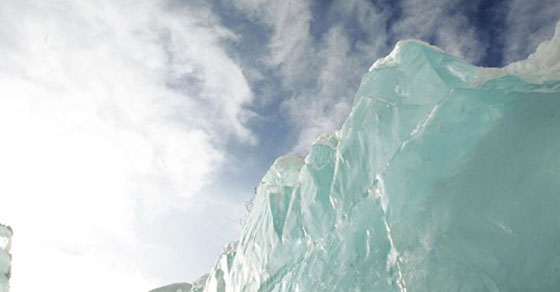
The ice used at the World Ice Art Championships in Fairbanks, Alaska, is often referred to as the Arctic diamond, and for good reason. Thick, crystal clear and glistening with a slight tinge of aquamarine, its gemlike qualities have garnered the attention of ice sculptors from around the world who make the annual trek to east-central Alaska to test their skills carving it into intricate swordfish, dragons, polar bears and anything else that sparks the imagination. The high-quality ice comes from a pond near North Pole, Alaska, located just southeast of Tanana Valley State Fairgrounds, where the annual competition is held. On average, volunteers from Ice Alaska, the organization responsible for executing the championships, harvest more than 4 million pounds of ice in preparation for the event, which has been taking place since 1990 and is one of the largest events of its kind in the world. Last year alone, more than 11,000 spectators came to watch as nearly 100 artists sawed and chiseled blocks of ice into gallery-worthy masterpieces.
Video: Siberian Lake's Ice Ring Mystery Solved Weather.com - February 6, 2020
What's causing mysterious 'ice rings' to form in the world's deepest lake? Live Science - February 6, 2020
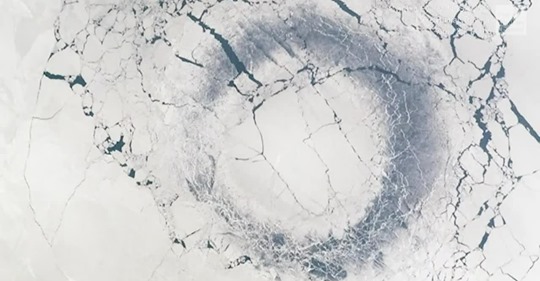
The humongous, mysterious "ice rings" that pockmark the world's deepest lake during Siberia's winter and spring months may look like icy crop circles, but they're not due to alien activity, atmospheric conditions or even, as previously thought, methane bubbles percolating from the lake's bottom. Rather, it appears that warm, swirling eddies of water under Lake Baikal's thick ice are responsible for these ice rings, some of which are up to 4 miles (7 kilometers) in diameter and can be seen from space, a new study finds.
Arctic sinkholes open in a flash after permafrost melt Live Science - February 6, 2020
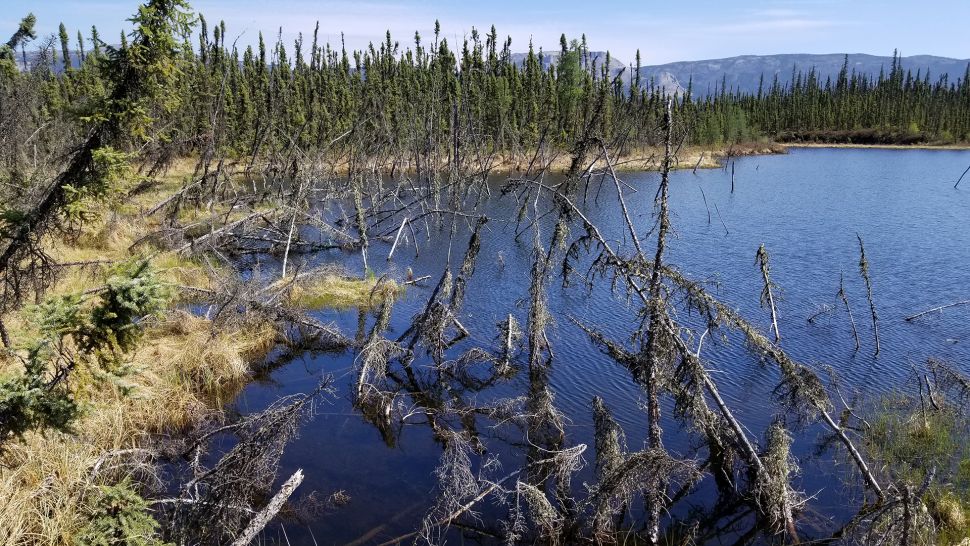
Arctic permafrost can thaw so quickly that it triggers landslides, drowns forests and opens gaping sinkholes. This rapid melt, described in a new study, can dramatically reshape the Arctic landscape in just a few months. Fast-melting permafrost is also more widespread than once thought. About 20% of the Arctic's permafrost - a blend of frozen sand, soil and rocks - also has a high volume of ground ice, making it vulnerable to rapid thawing. When the ice that binds the rocky material melts away, it leaves behind a marshy, eroded land surface known as thermokarst.
Surprisingly warm water found on underside of Antarctica's 'Doomsday Glacier' Live Science - January 30, 2020
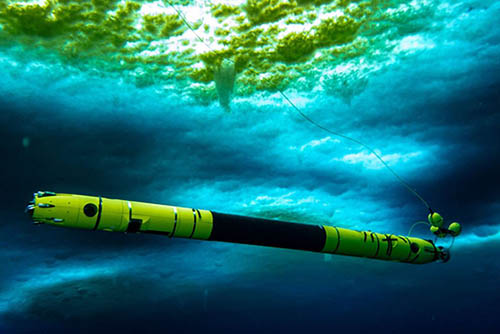
Scientists find record warm water in Antarctica, pointing to cause behind troubling glacier melt PhysOrg - January 30, 2020
A Never-Before-Seen Event Is Collapsing an Ice Sheet in the Russian Arctic Live Science - December 19, 2019
For the first time, scientists think they're watching a fast-moving river of ice being born. These so-called ice streams are rapid, long-lasting flows of ice that form in the middle of more static ice formations known as ice sheets. There are only a handful of them on Earth. They form in remote parts of the arctic and antarctic and, once established, can last decades or even centuries. Until now, no one had ever seen one emerge.
Laser technology uncovers medieval secrets locked in Alpine ice core PhysOrg - November 16, 2018
A new study has found ground-breaking evidence from an ice core in the Swiss-Italian Alps that proves the 7th century switch from gold to silver currencies in western Europe actually occurred a quarter of a century earlier than previously thought. The findings will have major implications on the history of the European monetary system, and what we thought we knew about trade and the economy during this period. The long-standing dating of all events and archaeological remains linked to the old dating of the first silver coinage will also have to change in light of the new study. During the second half of the 7th century AD the coin-using regions of North West Europe switched from gold to silver currency. This change was a significant point in history and resulted in major social and economic transformations which saw increased long-distance trade and the emergence of major ports and trading centres, such as London and continental counterparts around the Channel and southern North Sea coast.
NASA spots massive new iceberg three times the size of Manhattan in Antarctica Daily Mail - November 9, 2018
A close-up view of the rift separating Pine Island Glacier and iceberg B-46, as seen on an Operation IceBridge flight on November 7, 2018.
Wednesday's flight plan took the IceBridge team over Pine Island Glacier as part of the long-running campaign to collect year-over-year measurements of sea ice, glaciers, and critical regions of Earth's ice sheets. The giant berg may not last long - NASA said 'satellite imagery and the IceBridge flight showed that the main iceberg is already beginning to break up.
An ice age lasting 115,000 years in two minutes PhysOrg - November 6, 2018
An international research team used a computer model to reconstruct the history of glaciation in the Alps, visualizing it in a two-minute computer animation. The simulation aims to enable a better understanding of the mechanisms of glaciation.
12-Million-Ton Iceberg Threatens Greenland Village Live Science - July 17, 2018
Residents of a small town on Greenland's western coast were evacuated after a giant iceberg parked itself nearby, bringing a threat of a tsunami and flooding that could wash much of the village away.
Why Are Glaciers Melting from the Bottom? It's Complicated Scientific American - April 12, 2018
Glaciers in Greenland and Antarctica are losing ice at alarming rates, and warmer air isn't the only cause. Scientists increasingly agree that warm ocean water is seeping beneath the ice and melting it from the bottom up. It's a growing problem in Greenland, scientists say, and it may already be the dominant driver of melting glaciers in Antarctica. But while scientists know that warm water is interacting with the ice front in both places, exactly what's driving it there - and how climate change may be involved - is still an open question.
Video: Frozen in Time: Swiss Couple Just One of Many Findings Revealed by Melting Ice NBC - July 22, 2017
Two frozen bodies uncovered in the Swiss Alps this week are only the latest secret shrinking glaciers around the world have given up.
Ice has entombed and then returned numerous objects over the years, ranging in size from dormant bacteria to warplane wreckage. The items are often perfectly preserved, as was the case with this week's glacial discovery: A couple who had gone out to the meadow outside their Swiss home to milk cows 75 years ago - and never came back. Cold, dark, and oxygen-starved, the depths of glaciers are equivalent to the sci-fi of cryo-preservation in nature.
Stunning 'iceberg doodles' reveal how glaciers have transformed the ocean floor at Earth's poles Daily Mail - April 25, 2017
The Atlas of Submarine Glacial Landforms has been compiled by an international team of over 250 marine geologists and glaciologists over the last four years. The atlas charts the seafloor of both Polar Regions, and could allow researchers to interpret the history of Earth's large ice sheets, and the effect of environmental changes on the continents. An area the size of the UK is included in the book, showcasing a range of geological phenomena, including iceberg doodles and glacial lineations – ridges up to 10 kilometres long moulded on the beds of glaciers. More than 35 individual landforms feature, ranging from dramatic features in the East Siberian permafrost to trough-mouth fans - enormous sediment deposits that build up at the mouths of the largest glaciers.
Iceberg tourists flock to Newfoundland town BBC - April 20, 2017
Video: A small town in Newfoundland, Canada, has become a sudden tourist spot thanks to a new visitor - one of the first icebergs of the season. Canada's CBC News said that over the Easter weekend, the Southern Shore highway near the town of Ferryland was blocked with traffic as photographers - professional or amateur - pulled up to snap the hulking ice mountain.
The shocking animation that reveals how a massive Antarctic crack has grown 17 miles in the last two months - and experts say it is now 'inevitable' it will create one of the biggest icebergs ever seen Daily Mail - February 7, 2017
Shocking new images have revealed a massive Antarctic crack has grown 17 miles in the last two months, raising fears it is set to create one of the biggest icebergs ever seen. Since December, the crack on the Larsen C ice shelf has grown by the length of about five football fields each day. The crack has created a chunk of ice half the size of Jamaica which is breaking away from West Antarctica.
Secret World of Primeval Rivers Lies Beneath Greenland Glacier Live Science - July 5, 2016

A network of ancient rivers lies frozen in time beneath one of Greenland's largest glaciers, new research reveals. The subglacial river network, which threads through much of Greenland's landmass and looks, from above, like the tiny nerve fibers radiating from a brain cell, may have influenced the fast-moving Jakobshavn Isbrae glacier over the past few million years. The channels seem to be instrumental in controlling the location and form of the Jakobshavn ice stream - and seem to show a clear influence on the onset of fast flow in this region.
Video: Glaciers with a flotilla of 'ice sails' BBC - April 28, 2016

Rare and somewhat esoteric. These are the huge pyramids of ice that stand proud of the surface on some glaciers. To date, the phenomenon has only really been seen around the Karakoram mountain region of Pakistan. The Baltoro glacier, which begins life at the very summit of K2, has some particularly fine examples. Up to 25m in height and with widths of up to 90m, their triangular shapes when viewed from a distance give the impression of a flotilla of sail boats. Now, scientists are getting a handle on how these giant "ice sails" form and wither over time, and how the processes involved depend on the special conditions that exist in the Karakoram region.
Video: NASA: 10,000-year-old Antarctic ice shelf will disappear by 2020 CNN - May 16, 2015
One of the last remaining sections of Antarctica's Larsen B Ice Shelf is dramatically weakening, according to a new NASA study. The study predicts that what remains of the once-prominent ice shelf, a thick floating platform of ice, most likely will "disintegrate completely" before the end of this decade. Ice shelves are extensions of glaciers and function as barriers. Their disappearance means glaciers potentially will diminish more quickly, as well, increasing the pace at which global sea levels rise. The Larsen B Ice Shelf has existed for at least 10,000 years.

Antarctic Ice Shelf in Last Throes of Collapse Live Science - May 16, 2015
What matters is how much more ice the glaciers will dump into the ocean once this ice shelf is removed. The glaciers that were behind the vanished section of the Larsen B ice shelf sped up by as much as 8 times their former rate after the ice crumbled over a six-week period in 2002, earlier studies showed. Researchers think the surface warming is melting the ice shelves, triggering a cascade of events that eventually leads them to catastrophically collapse. But recent research also points to melting from below, from warmer ocean water. Scientists are tracking the ongoing changes in the Antarctica Peninsula ice shelves because the collapse could indicate what may happen across the entire continent.
Video: Icebergs 'have sound signature' BBC - January 29, 2015

Listening to icebergs could help to assess the extent of glacier melt, scientists report. Researchers have found different types of icebergs have their own acoustic signature as they calve away from the ice. Monitoring this could help to determine how much ice is being lost and the effect this could have on global sea level rise. Using acoustics they can get very accurate data. They just place the hydrophones - underwater microphones - in the water and listen to the sounds.
Icebergs once drifted to Florida, new climate model suggests PhysOrg - October 13, 2014

Using a first-of-its-kind, high-resolution numerical model to describe ocean circulation during the last ice age about 21,000 year ago. Icebergs and meltwater from the North American ice sheet would have regularly reached South Carolina and even southern Florida. The models are supported by the discovery of iceberg scour marks on the sea floor along the entire continental shelf.
'Jellyroll' Ice Sculptures Discovered Under Greenland Ice Sheet Live Science - June 17, 2014
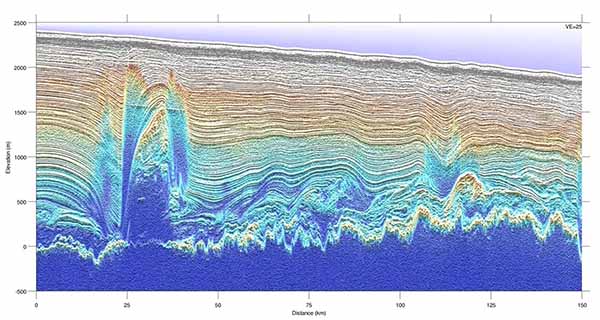
The Greenland ice sheet may look like a vast expanse of white, but scientists peering beneath the smooth veil have found a fun house of sorts, full of giant jellyroll-like ice sculptures that could rival city skyscrapers in height and the whole of Manhattan in width.
Comet theory false: Doesn't explain Ice Age cold snap, Clovis changes, animal extinction Science Daily - May 14, 2014
New research has demonstrated again that a comet didn't spark climate change at the end of the Ice Age, killing the Clovis peoples and causing mass animal extinction. Supposed impact indicators are too old or too young to indicate an ancient comet that proponents claim sparked a late Ice Age calamity, according to new research. The researchers found previous dating of Ice Age boundary layers by proponents contained widespread errors.
Scotland had a glacier up to 1700s, say scientists BBC - January 21, 2014
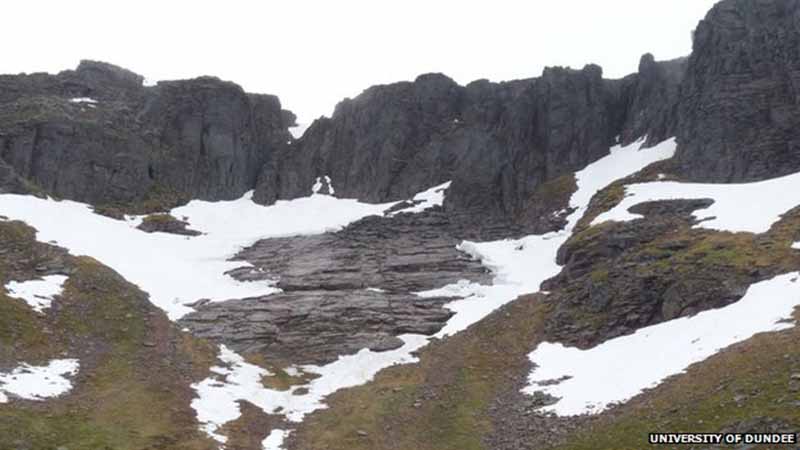
A glacier was still in place in Scotland within the past 400 years - 11,000 years less than previously thought - it has been suggested. The moraines were formed within the last couple of thousand years, which shows that a Scottish glacier existed more recently than we had previously thought.